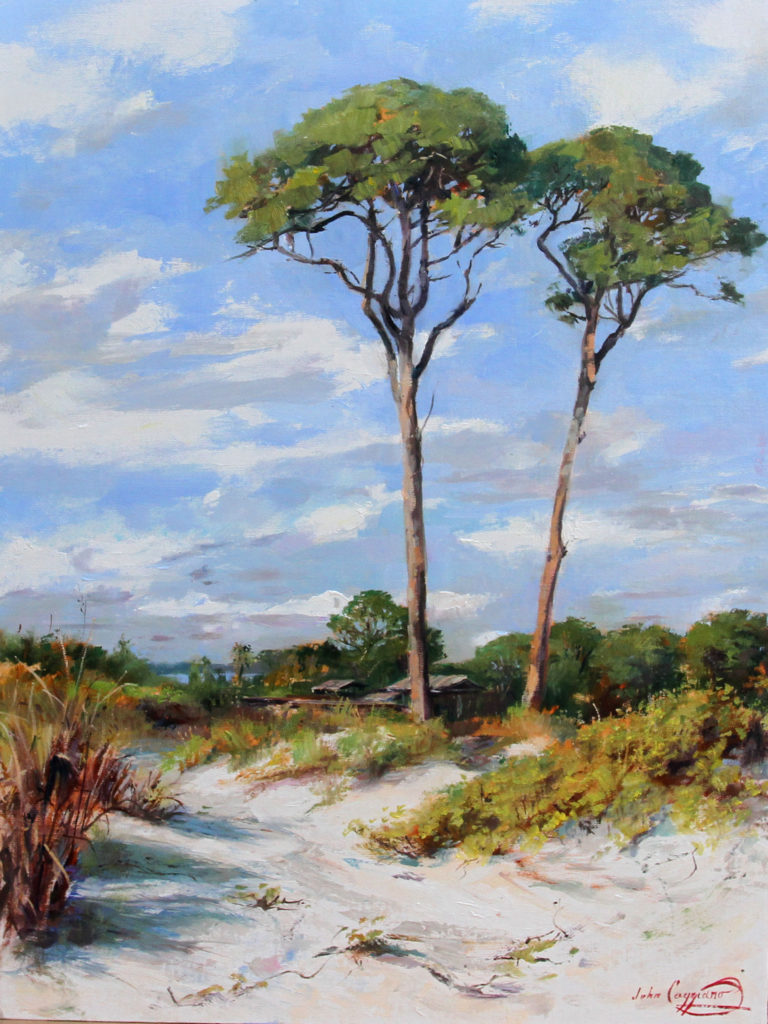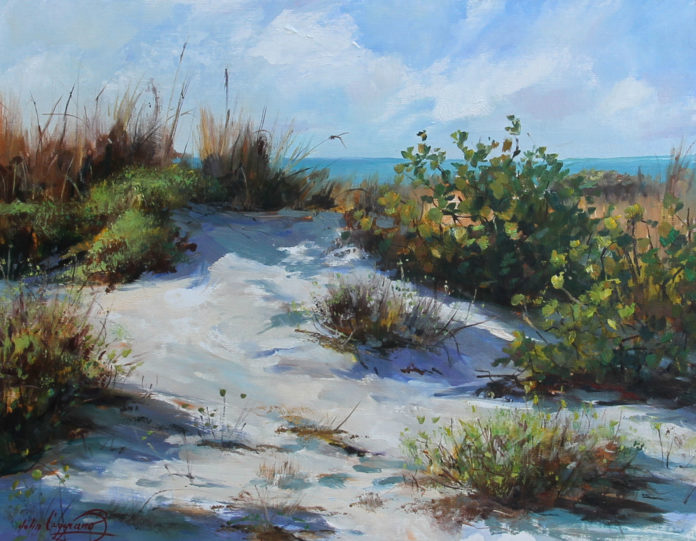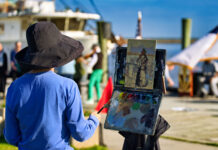John Caggiano painted a picture of a beach in the Venice, Florida area titled “A Touch of Paradise.” But it was the artist who gave it that magic touch, not nature.
In that painting, the sky was clear and beautiful. But depicting that would have created a very large, static blue shape dominating most of the painting. “Here in Florida the skies are generally clear,” says Caggiano. “It’s like that funny commercial where a tiny little poofy cloud obstructs the sun for a second, and then it goes away and people cheer. And someone says, ‘The weather was so much better yesterday.’ There were no clouds, but I like to play with that imagery. It gives the piece some aerial perspective. So I invented the cloud. In creating this cloud, I played with my brush as I put in the sky, and I could see a form emerging. I said, ‘That’s what I need. That would look good.’ So I put a massive cloud sort of coming toward us that gives the painting some monumentality. I just do what I have to.”

Most people love the beach. But it can be boring to paint. Not for Caggiano, who has a great knack for moving elements around, making up new ones, enhancing color, or eliminating distractions in the design. In another piece, titled “Leaning Palm,” the artist even manipulated the focal point. “The palm was interesting subject matter, framing portions of the ocean in the background, and the trees on the left really interested me,” Caggiano recalls. “But the palm was standing up straight. If I had left that vertical that way, it would have been not only boring, but it would have stifled the composition. It needed an interesting directional. And then on the extreme right I pushed some palm fronds in there even though they were a bit out of view. Otherwise, the composition would not have been balanced.”

In other beach paintings from the Venice area, Caggiano shows some of the ocean in the background where you actually couldn’t see it, places a sandy path where one doesn’t exist, rearranges ground vegetation to create interesting shapes, inserts palm trees where verticals are needed, removes piers that disrupt the peacefulness of the scene, and warms up foliage by letting some of his warm underpainting show through. “When I go to a location I see the potential of the scene,” Caggiano says. “Sometimes it’s already set up and ready to go. God set it up that way and said, ‘Hey, paint it.’ Other times I have to move things around. That’s just what artists do.”
So Caggiano takes the basic building blocks of the scene, balances shapes and balances color temperature, and generally collaborates with nature to make a picture. “I have an instinctive approach to painting,” he says. “It’s about breathing, calmness, and balance. I work to have the eye led around the canvas, involving all the elements I’m drawn to. I like light and color and things that breathe.”

Caggiano usually finishes a painting in one session, but for an artist who uses his imagination almost as much as his observations, that can mean an eight-hour period—he’s not worried about chasing the light. He sketches a “cartoon” on the surface with red iron oxide, at first just geometric shapes, and then values, starting with the darkest darks. By the time this monochromatic underpainting is done, parts of the thinly applied paint are already dry, so he can start adding color. The darkest areas of foliage are often first to get color. Caggiano used to use only a palette knife for color application, but these days he uses a brush, and picks up the knife only for certain areas.

The painter is a Northeasterner, but he has strong ties and artist friends in Florida, and spends quite a bit of time in the Sunshine State. “I paint all the time — it’s a working atmosphere down here, painting during the day and having dinner with artist friends,” Caggiano says. “I couldn’t just be hanging out here. It’s too beautiful — plus, you know, I have to work. I sell in Naples at a gallery, so many of these beach paintings will wind up there. And I can do larger studio work if someone wants it.”

The area has much to pull him in and keep him there … and what it lacks, Caggiano is ready and capable of adding from his artistic mind. “The beaches around the Venice area stretch across several villages,” he says. “As you can guess, you get different views of the same subject matter every day to give you all new paintings. I love the dunes, the growth that is there — I couldn’t tell you what the vegetation is, but it has a variety of color and texture and casts shadows depending on the time of day. I can just do the dunes, I can do lots of palm trees, or I can go to other areas where it is mostly beach and people.”
And if that’s not enough, he’ll supply the rest from his imagination.




